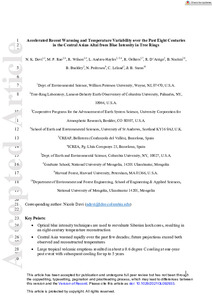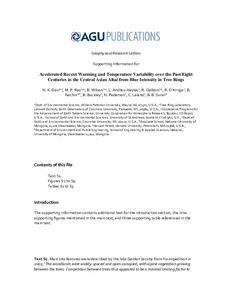Please use this identifier to cite or link to this item:
http://hdl.handle.net/20.500.12164/3080Full metadata record
| DC Field | Value | Language |
|---|---|---|
| dc.contributor.author | Davi, Nicole K. | - |
| dc.contributor.author | Rao, M. P. | - |
| dc.contributor.author | Wilson, R. | - |
| dc.contributor.author | Andreu-Hayles, L. | - |
| dc.contributor.author | Oelkers, Rose | - |
| dc.contributor.author | D'Arrigo, R. | - |
| dc.contributor.author | Nachin, B. | - |
| dc.contributor.author | Buckley, B. | - |
| dc.contributor.author | Pederson, N. | - |
| dc.contributor.author | Leland, C. | - |
| dc.contributor.author | Suran, B. | - |
| dc.date.accessioned | 2021-08-16T14:25:37Z | - |
| dc.date.available | 2021-08-16T14:25:37Z | - |
| dc.date.issued | 2021-07-26 | - |
| dc.identifier.issn | 1944-8007 | - |
| dc.identifier.uri | https://agupubs.onlinelibrary.wiley.com/doi/10.1029/2021GL092933 | - |
| dc.identifier.uri | http://hdl.handle.net/20.500.12164/3080 | - |
| dc.description | We have reconstructed nearly 750 years (1269-2004 C.E.) of summer temperatures in Mongolia based on Siberian Larch tree rings, using a relatively new analysis method called delta blue-light intensity (DBI). This is a region of the world with relatively few long records of climate, and one that is experiencing unprecedented warming over the last three decades. This warming is projected to intensify and reach levels that go beyond the range of natural climate variability that is estimated by our reconstruction. In our analysis, we capture the warming trends observed in instrumental records as well as extreme-cold events that coincide with the well-documented, large-scale volcanic events of 1459, 1601, 1810-1816, and 1885. Our results add to an increasing number of studies detailing the potential of DBI to improve paleoclimate models as compared to traditional tree-ring width analysis, especially in Siberian Larch and other species that express a significant heartwood/sapwood color change. | en_US |
| dc.description.abstract | Warming in Central Asia has been accelerating over the past three decades and is expected to intensify through the end of this century. Here we develop a summer temperature reconstruction for western Mongolia spanning eight centuries (1269-2004 C.E.) using delta blue intensity measurements from annual rings of Siberian larch. A significant cooling response is observed in the year following major volcanic events and up to 5 years post-eruption. Observed summer temperatures since the 1990s are the warmest over the past eight centuries, an observation that is also well captured in CMIP5 climate model simulations. Projections for summer temperature relative to observations suggest further warming of between ∼3-6°C by the end of the century (2075-2099 cf. 1950-2004) under the RCP4.5 and RCP8.5 emission scenarios. We conclude that projected future warming lies beyond the range of natural climate variability for the past millennium as estimated by our reconstruction. | en_US |
| dc.language.iso | en_US | en_US |
| dc.publisher | Geophysical Research Letters | en_US |
| dc.rights | Attribution-NonCommercial-NoDerivs 3.0 United States | * |
| dc.rights.uri | http://creativecommons.org/licenses/by-nc-nd/3.0/us/ | * |
| dc.subject | Environmental science | en_US |
| dc.title | Accelerated Recent Warming and Temperature Variability over the Past Eight Centuries in the Central Asian Altai from Blue Intensity in Tree Rings | en_US |
| dc.type | Article | en_US |
| Appears in Collections: | Environmental Science | |
Files in This Item:
| File | Description | Size | Format | |
|---|---|---|---|---|
| AltaiTreeRingsAcceleratedWarming.pdf | 5.31 MB | Adobe PDF |  View/Open | |
| AltaiTreeRingsAcceleratedWarming-Supporting.pdf | 1.21 MB | Adobe PDF |  View/Open |
This item is licensed under a Creative Commons License

